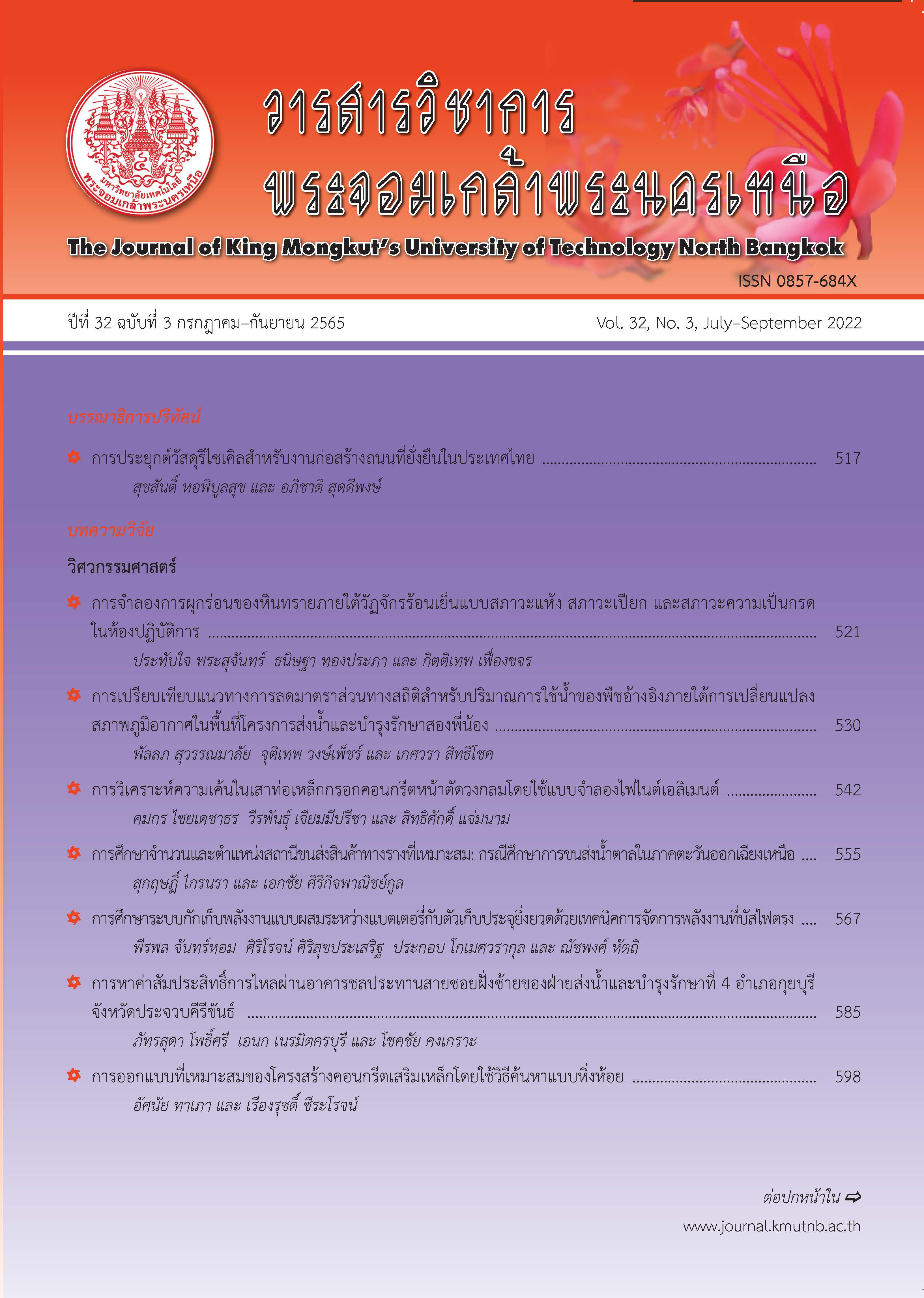สมบัติทางกายภาพของเถ้าลอยแคลเซียมสูงจีโอพอลิเมอร์คอนกรีตและคอนกรีตปกติเมื่อใช้เศษคอนกรีตแทนที่หินปูนย่อย
Main Article Content
บทคัดย่อ
งานวิจัยนี้มีจุดประสงค์เพื่อศึกษาอิทธิพลของการใช้คอนกรีตรีไซเคิลเป็นมวลรวมหยาบในเถ้าลอยแคลเซียมสูงจีโอพอลิเมอร์คอนกรีตและคอนกรีตปกติ โดยศึกษาปริมาณการแทนที่คอนกรีตรีไซเคิลในมวลรวมหยาบธรรมชาติร้อยละ 0, 20, 40, 60, 80 และ 100 ที่มีต่อระยะเวลาก่อตัว กำลังอัด มอดุลัสยืดหยุ่น และอัตราส่วนปัวซองของคอนกรีตที่อายุการบ่มเท่ากับ 1 วัน โดยออกแบบส่วนผสมของเถ้าลอยแคลเซียมสูงจีโอพอลิเมอร์คอนกรีตตามงานวิจัยที่ผ่านมา โดยใช้อัตราส่วนสารละลายต่อวัสดุประสานเท่ากับ 0.50 อัตราส่วนสารละลายโซเดียมซิลิเกตต่อสารละลายโซเดียมไฮดรอกไซด์เข้มข้น 10 โมลาร์ เท่ากับ 1.0 ส่วนคอนกรีตปกติถูกออกแบบตามมาตรฐาน ACI211.1-91 ผลการทดสอบ พบว่า ระยะเวลาการก่อตัวของเถ้าลอยแคลเซียมสูงจีโอพอลิเมอร์คอนกรีตและคอนกรีตปกติมีแนวโน้มลดลงตามปริมาณการใช้คอนกรีตรีไซเคิลที่เพิ่มขึ้น ส่วนกำลังอัดและมอดุลัสยืดหยุ่นของเถ้าลอยแคลเซียมสูงจีโอพอลิเมอร์คอนกรีตมีแนวโน้มเพิ่มขึ้นแต่อย่างไรก็ตามกำลังอัดและมอดุลัสยืดหยุ่นของคอนกรีตปกติมีแนวโน้มลดลงตามปริมาณการใช้คอนกรีตรีไซเคิลที่เพิ่มขึ้น ขณะที่อัตราส่วนปัวซองของทั้งระบบเถ้าลอยแคลเซียมสูงจีโอพอลิเมอร์คอนกรีตและคอนกรีตปกติมีแนวโน้มลดลงตามปริมาณคอนกรีตรีไซเคิลในส่วนผสมซึ่งสอดคล้องกับค่าความเครียดอัดที่จุดความเค้นสูงสุดมากขึ้น จากผลการทดสอบข้างต้นสามารถสรุปได้ว่า คอนกรีตรีไซเคิลสามารถใช้ทดแทนมวลรวมหยาบธรรมชาติสำหรับผลิตคอนกรีตได้โดยเฉพาะอย่างยิ่งในระบบของจีโอพอลิเมอร์
Article Details

อนุญาตภายใต้เงื่อนไข Creative Commons Attribution-NonCommercial-NoDerivatives 4.0 International License.
บทความที่ลงตีพิมพ์เป็นข้อคิดเห็นของผู้เขียนเท่านั้น
ผู้เขียนจะต้องเป็นผู้รับผิดชอบต่อผลทางกฎหมายใดๆ ที่อาจเกิดขึ้นจากบทความนั้น
เอกสารอ้างอิง
L. K. Turner and F. G. Collins, “Carbon dioxide equivalent (CO2-e) emissions: A comparison between geopolymer and OPC cement concrete,” Construction and Building Materials, vol. 43, pp. 125–130, 2013.
T. Phoo-ngernkham, S. Hanjitsuwan, C. Suksiripattanapong, J. Thumrongvut, J. Suebsuk, and S. Sookasem, “Flexural strength of notched concrete beam filled with alkali activated binders under different types of alkali solutions,” Construction and Building Materials, vol. 127, pp. 673–678, 2016.
J. Davidovits, “Geopolymers - Inorganic polymeric new materials,” Journal of Thermal Analysis, vol. 37, no. 8, pp. 1633–1656, 1991.
K. Chompoovong, T. Phoo-ngernkham, S. Detphan, C. Detphan, S. Hanjitsuwan, and P. Chindaprasirt, “Effect of portland cement content on compressive strength and elastic modulus of high-calcium fly ash Geopolymer mortar containing various type of alkali solution,” The Journal of KMUTNB, vol. 30, no. 4, 2020 (in Thai).
K. Chompoovong, T. Phoo-ngernkham, S. Detphan, C. Detphan, S. Hanjitsuwan, and P. Chindaprasirt, “Properties of pervious geopolymer concrete made from high-calcium fly ash containing calcium carbide residue,” The Journal of KMUTNB, vol. 30, no. 2, pp. 280–290, 2020 (in Thai).
C. Detphan, S. Detphan, K. Chompoovong, T. Phoo-ngernkham, S. Hanjitsuwan, and P. Chindaprasirt, “Mechanical properties of highcalcium fly ash geopolymer with nano-SiO2 particle sizes,” The Journal of KMUTNB, vol. 31, no. 1, 2021 (in Thai).
C. Detphan, T. Phoo-ngernkham, S. Detphan, K. Chompoovong, S. Hanjitsuwan, and P. Chindaprasirt, “Factors of FGD-gypsum replacement and alkaline solution ratio on compressive strength and microstructure of fly ash geopolymer,” The Journal of KMUTNB, vol. 31, no. 4, 2021 (in Thai).
T. Poltue, A. Suddeepong, and S. Horpibulsuk, “Strength of recycled concrete aggregate binding with fly ash-rice husk ash geopolymer for pavement sub bases application,” KMUTT Research and Development, vol. 40, no. 4, pp. 567–581, 2017 (in Thai).
T. Saisut, “Recycled coarse aggregate by residual concrete pile,” in Proceedings of the 9th Kasetsart University Kamphaeng Saen Campus Conference, 2011, pp. 1725–1735 (in Thai).
C. Rattanashotinunt, N. Makaratat, W. Tangchirapat, C. Jaturapitakkul, and K. Manauttananuiul, “Properties of concrete made from industrial wastes containing calcium carbide residue palm oil fuel ash rice husk-bark ash and recycled aggregates,” The Industrial Technology, vol. 12, no. 3, pp. 37–52, 2016 (in Thai).
A. Siriwattanakarn, A. Wongsa, V. Sata, and P. Chindaprasirt, “Pressed geopolymer concrete containing recycle aggregates,” presented at the 23th National convention on Civil Engineering, Nakhon Nayok, Thailand, 2017 (in Thai).
Y. Zaetang, V. Sata, A. Wongsa, and P. Chindaprasirt, “Properties of pervious concrete containing recycled concrete block aggregate and recycled concrete aggregate,” Construction and Building Materials, vol. 111, pp. 15–21, 2016.
V. Sata, A. Wongsa, and P. Chindaprasirt, “Properties of pervious geopolymer concrete using recycled aggregates,” Construction and Building Materials, vol. 42, pp. 33–39, 2013.
T. Phoo-ngernkham, C. Phiangphimai, N. Damrongwiriyanupap, S. Hanjitsuwan, J. Thumrongvut, and P. Chindaprasirt, “A mix design procedure for alkali-activated highcalcium fly ash concrete cured at ambient temperature,” Advances in Materials Science and Engineering, vol. 2018, pp. 1–13, 2018.
Standard Practice for Selecting Proportions for Normal, Heavyweight, and Mass Concrete, American Concrete Institute ACI 211.1-91, 1991.
Standard Test Method for Time of Setting of Concrete Mixtures by Penetration Resistance, Annual Book of ASTM Standard C403/C403M-16, 2016.
Standard Test Method for Compressive Strength of Cylindrical Concrete Specimens, Annual Book of ASTM Standard C39/C39M-17, 2017.
Standard Test Method for Static Modulus of Elasticity and Poisson's Ratio of Concrete in Compression, Annual Book of ASTM Standard C469, 2002.
Y. C. Liang, Z. M. Ye, F. Vernerey, and Y. Xi, “Development of processing methods to improve strength of concrete with 100% recycled coarse aggregate,” Journal of Materials in Civil Engineering, vol. 27, no. 5, pp. 04014163, 2015.
S. Hanjitsuwan, T. Phoo-ngernkham, and N. Damrongwiriyanupap, “Comparative study using Portland cement and calcium carbide residue as a promoter in bottom ash geopolymer,” Construction and Building Materials, vol. 133, pp. 128–134, 2017.
S. Pangdaeng, T. Phoo-ngernkham, V. Sata, and P. Chindaprasirt, “Influence of curing conditions on properties of high calcium fly ash geopolymer containing Portland cement as additive,” Materials & Design, vol. 53, pp. 269–274, 2014.
T. Phoo-ngernkham, S. Hanjitsuwan, L.Y. Li, N. Damrongwiriyanupap, and P. Chindaprasirt, “Adhesion characterization of portland cement concrete and alkali-activated binders under different types of calcium promoters,” Advances in Cement Research, vol. 31, no. 2, pp. 69–79, 2019.
R. Somna, C. Jaturapitakkul, W. Chalee, and P. Rattanachu, “Effect of the water to binder ratio and ground fly ash on properties of recycled aggregate concrete,” Journal of Materials in Civil Engineering, vol. 24, no. 1, pp. 16–22, 2012.
W. Kroehong, T. Sinsiri, C. Jaturapitakkul, and P. Chindaprasirt, “Effect of palm oil fuel ash fineness on the microstructure of blended cement paste,” Construction and Building Materials, vol. 25, no. 11, pp. 4095–4104, 2011.
D. J. Cook and P. Chindaprasirt, “A mathematical model for the prediction of damage in concrete,” Cement and Concrete Research, vol. 11, no. 4, pp. 581–90, 1981.
M. Shariq, J. Prasad, and H. Abbas, “Effect of GGBFS on age dependent static modulus of elasticity of concrete,” Construction and Building Materials, vol. 41, pp. 411–418, 2013.

